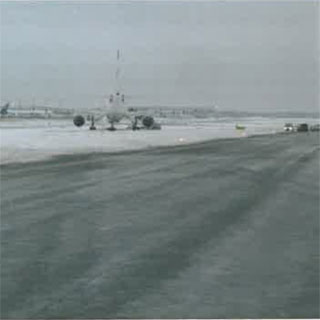
final position of Iran Air – A300 (EP-IBB) flight IR762
Iran Air flight IR762 , an Airbus A300-600 with the registration EP-IBB, was to commence a flight from Stockholm/Armanda Airport to Tehran in Iran. Following normal preparations, the aircraft was taxied out to runway 19R for take-off.
The runway conditions were reported as good, with some patches ofice along the runway. The investigation has however revealed that the runway was contaminated and likely had coefficients of friction which fell short of the reported values.
After taxiing out, the crew began routine take-off procedures by increasing engine thrust during acceleration on the runway. After just over 10 seconds, one or more of the edges in a repaired section of the engine – the diffuser aft air seal- separated, thereby triggering a sequence which led to a sudden engine failure.
No warning messages were announced in the cockpit at the time ofthe failure; the pilots only noticed the engine failure through a muffled bang at the same time as the aircraft began to veer to the left. The initial veer, immediately after the engine seizure, was a result of the nose wheel being unable to gain sufficient force against the contaminated surface to counteract the moment which arose when the right engine – for a duration of approximately 1.5 seconds – supplied full thrust at the same time as the left engine rapidly lost thrust. The highest speed registered during the sequence was 59 knots (110 kmIh).
The engine failure of Iran Air flight IR762 occurred at a speed less than 59 Knots
Despite the co-pilot’s reactions – retarding the thrust levers after just over a second, at the same time as steering and opposite rudder were applied – the veer could not be corrected and the aircraft ran off the runway, mainly caused by the forces from the moment in combination with the slippery surface.
The chances of stopping the continued veer were probably reduced by the fact that the pilots did not apply any differential braking in the opposite direction.
The investigation also showed that the pilots’ braking was unintentionally asymmetrical, with a higher brake pressure on the “wrong side”, i.e., in the direction in which the aircraft ran off the runway.
Even if this fact may have affected the aircraft’s movement pattern, such an impact has, however, not been possible to determine with any reasonable degree of certainty.
It is, nevertheless, noteworthy that analyzed data from the FDR show that the recorded brake angles (asymmetric braking) were not accompanied or followed by any corresponding change in the rate of heading change.
There are no specific certification requirements for aircraft design organization to show that the aircraft is maneuverable in the event of a sudden loss of engine thrust during the initial stage of the take-off sequence. There are also no mandatory requirements for training regarding how to handle sudden losses of engine thrust during the initial stage of the take-off sequence for pilots in training or recurrent training for this class of aircraft.
The following causal factors were identified:
Operational :
- Deficiencies in the certification process for large aircraft with wing-mounted engines with regard to requirements for yaw stability in the event of sudden loss of engine power in the speed range below VMCG.
- Deficiencies in the pilot training with regard to training for sudden losses of engine thrust in the speed range below VMCG.
Technical :
- Deficiencies in the approval and follow-up of the Dabbler TIG Weld repair on the engine ‘s diffuser aft air seal.
Download Report

0 Comments